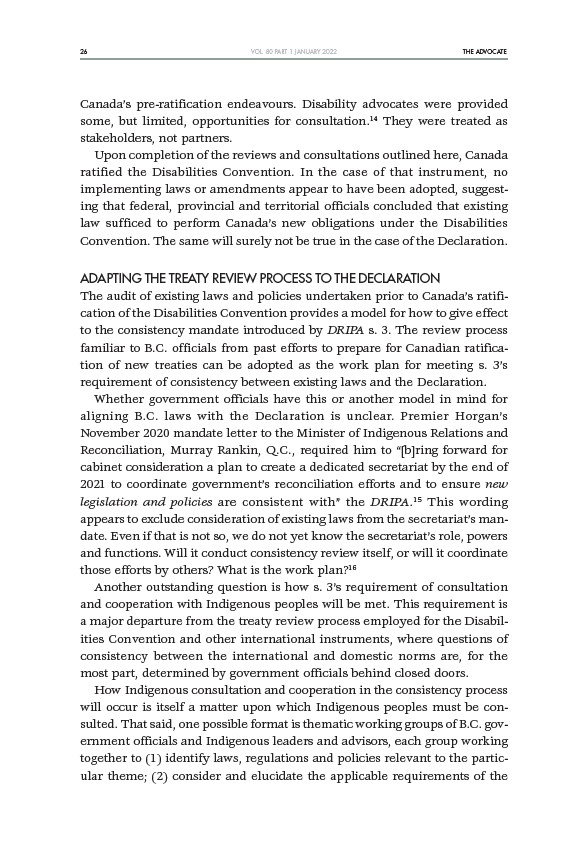
26 THE ADVOCATE
VOL. 80 PART 1 JANUARY 2022
Canada’s pre-ratification endeavours. Disability advocates were provided
some, but limited, opportunities for consultation.14 They were treated as
stakeholders, not partners.
Upon completion of the reviews and consultations outlined here, Canada
ratified the Disabilities Convention. In the case of that instrument, no
implementing laws or amendments appear to have been adopted, suggesting
that federal, provincial and territorial officials concluded that existing
law sufficed to perform Canada’s new obligations under the Disabilities
Convention. The same will surely not be true in the case of the Declaration.
ADAPTING THE TREATY REVIEW PROCESS TO THE DECLARATION
The audit of existing laws and policies undertaken prior to Canada’s ratification
of the Disabilities Convention provides a model for how to give effect
to the consistency mandate introduced by DRIPA s. 3. The review process
familiar to B.C. officials from past efforts to prepare for Canadian ratification
of new treaties can be adopted as the work plan for meeting s. 3’s
requirement of consistency between existing laws and the Declaration.
Whether government officials have this or another model in mind for
aligning B.C. laws with the Declaration is unclear. Premier Horgan’s
November 2020 mandate letter to the Minister of Indigenous Relations and
Reconciliation, Murray Rankin, Q.C., required him to “bring forward for
cabinet consideration a plan to create a dedicated secretariat by the end of
2021 to coordinate government’s reconciliation efforts and to ensure new
legislation and policies are consistent with” the DRIPA.15 This wording
appears to exclude consideration of existing laws from the secretariat’s mandate.
Even if that is not so, we do not yet know the secretariat’s role, powers
and functions. Will it conduct consistency review itself, or will it coordinate
those efforts by others? What is the work plan?16
Another outstanding question is how s. 3’s requirement of consultation
and cooperation with Indigenous peoples will be met. This requirement is
a major departure from the treaty review process employed for the Disabilities
Convention and other international instruments, where questions of
consistency between the international and domestic norms are, for the
most part, determined by government officials behind closed doors.
How Indigenous consultation and cooperation in the consistency process
will occur is itself a matter upon which Indigenous peoples must be consulted.
That said, one possible format is thematic working groups of B.C. government
officials and Indigenous leaders and advisors, each group working
together to (1) identify laws, regulations and policies relevant to the particular
theme; (2) consider and elucidate the applicable requirements of the